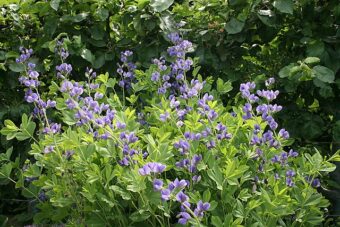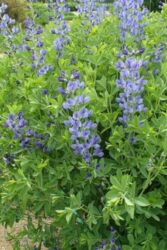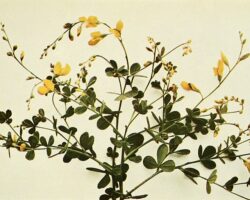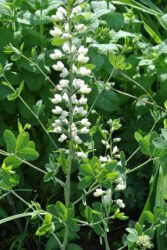In this article, we will discuss how to grow the not often seen Baptisia in containers. Baptisia is actually a member of the Legume (Pea family), where blue pea-like flowers are produced in summer. These are followed by black seed pods.
This herbaceous perennial is often seen as an inferior plant to the often grown cousin of Lupine. It is a native woodland and grassland plant found in Eastern and Southern North America where 26 species are known to exist. The ones you are likely to find in garden centres and online are based on Baptisia australis.

The leaves are made up of three leaflets that are either light yellow-green to dark blue-green. Above these leaflets, the flower appears that are mostly blue in shade but some species have white (B. lactea) and yellow flowers (B. tinctoria). The common name is false indigo as the early European settlers used the flowers to dye their clothes an indigo colour.
The flower spikes can be over 61cm high and will last for 6 weeks. Find out how to grow these beauties in containers in this article.
GROWING BAPTISIA IN CONTAINERS
You have a choice of how you can grow Baptisia, either from seeds or garden-ready plants. From seed, it can take 3 years for the plant to flower and so patience is required.
GROWING BAPTISIA FROM SEED
First, you will need as fresh as seeds as possible as old seeds do not readily germinate. When you buy your seeds you will need to chip or scarify the seeds. To do this, either rub two sheets of sandpaper over the seeds or nick one end of the seed with a sharp knife.
After this, you will need to soak your seeds in 60 degrees Celsius water for 12 hours. After this, you will need to make a free-draining growing media by mixing 3 parts of sowing compost with 1 part of horticultural grit. Place this mixture in a 7.5cm pot as it hates to be transplanted and place the seed at a depth of 6mm. Cover with some more fine grit and wait for germination. You will then need to place the pot inside a fridge for 12 weeks as cold stratification is required.
After that, you will need to place it in a warm room where after 2 to 3 weeks the seed will germinate. Allow the seedlings to grow on and once they are big enough you will need to place the young plants in a cold frame to acclimatise over winter before planting out in spring when the dangers of frost have passed.
YOU CAN TREAT SHOP-BOUGHT AND HOME-REARED PLANTS THE SAME WAY

At this stage shop-bought, garden-ready plants and home-reared plants can be treated the same way. As it is a big plant, you will need to buy a large container- a half-barrel is ideal. No matter what you use, make sure it has plenty of drainage holes at the bottom. On top of this add a 1cm layer of gravel to aid drainage and on top of this add to 5cm below the rim multipurpose compost.
Dig a hole that is slightly bigger than the root ball it came in the original container, Place the plant in so that the top of the root ball is at the same level as the top surface of the compost. Backfill with the compost so that no gap remains, using more compost if necessary. Firm the plant on and water well.
CARE INSTRUCTIONS
Place the container in a location where it will get the most light. More light means better growth. You will need to water regularly until the plant is established and after this, it will tolerate drought pretty well. It is best to water when 5cm below the top surface of the compost feels dry to the touch.
In spring, it is advised to feed your plants with a slow-release fertilizer to give them a boost throughout the growing season.
Once the flowers are spent you can leave the spent seedpods on the plant to give winter interest. In spring, you can cut down flower spikes close to the leaves.

As suggested earlier in this article, you cannot transplant divisions as they will not take, it is, therefore, recommended that you start plants from seed or buy new stock to replenish your plants.
PESTS AND DISEASES
They are generally pests and diseases free, but they can suffer from fungal conditions, especially so if the compost is overly wet. It is important that the growing media is free-flowing and that air circulates around the plant.
VARIETIES TO GROW

In general, the species to grow is B. australis which grows up to 1.2m tall. It has long leaves made up of three leaflets, where it produces indigo blue flowers that have orange stamens.
Others include B. lactea which produces white flowers with purple freckles and B. tinctoria which grows like a wildflower with its yellow blooms.
CONCLUSIONS
In this article, we have discussed how to grow the perennial Baptisia in containers. If you want to grow a plant in the legume family that is blue in colour (or yellow or white), easy to look after, and easy to care for, then Baptisia is for you. It makes a great addition and an alternative to lupine as well.
This is a perennial that will look good in containers. If you have any questions or comments on growing Baptisia in containers, please do so in the comment box below.
Happy Baptisia growing.

I have some dead stems on my wild yellow false indigo. It is in a container. Just purchased this spring 2022. It receives West sun from around noon til dark. Any suggestions as to the problem. Could the roots be too wet ? The pot does have drainage and currents has almost two inches of dry soil at the top.
Hi Dee
It could be a number of reasons from overwatering to the plant not establishing too well. You are looking after it right but I suggest you cut the wilted stems away. It may take time but next year it should be better.
Thanks
Antonio
I Doug my up by mistake ,with my tractor bucket . Late summer after flowering I put it in a container. It started too grow again 😏What should I do for winter Thanks
Hi Lee
Baptisia is a very hardy perennial. The best way to overwinter them is in a minimally heated greenhouse kept slightly above freezing. However, they may also be overwintered outdoors under a heavy frost blanket or in an unheated greenhouse.
Thanks
Antonio
I’m thinking about moving mine into a pot and keeping it on the deck as the deer chew it down to zilch! I’m in MI and our garage is heated to 45 in the winter. Do you think this will work?
Hi Gordeen
That should be okay provided you keep watering to a minimal to avoid root rot. You can bring them out once frosts have passed.
Thanks
Antonio